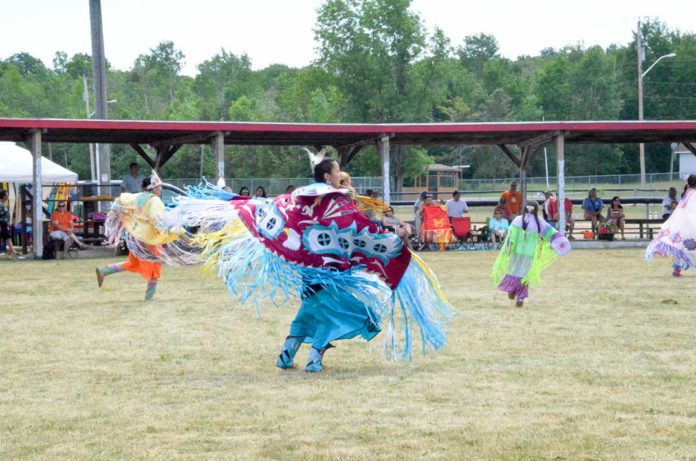by Betty Bardswich
M’CHIGEENG—The Ojibwe Cultural Foundation (OCF) in M’Chigeeng is one of Manitoulin’s many treasures. Situated in the downtown area of the First Nation, this is a spot not to missed. Under the tutelage of Art Director Anong Beam, the establishment has undergone revitalization with new exhibits, new displays and a new gift shop to showcase local First Nation artists.
There is a treasure trove of articles in the shop. There are earrings, necklaces and bracelets made of turquoise and sterling silver, pottery, hand carved bowls made of maple burl wood by Ferdinand Paibomsai and carvings by Chris Bebonang. There are also painted rocks, done by Peggy MacIntyre who teaches painting on Thursdays, which is cultural expressions night at OCF. The book section has an excellent number with the titles ‘Portraits of Spirit Island,’ ‘Ojibwe Narratives,’ ‘First Nation Cooking,’ ‘Nanabush Loses his Eyeballs’ as well as colouring books, CDs, and post cards showing animals and Apache Indian scout AR-KE-KE-TAH, the head chief of the Sioux during their forced settlement on reservations.
Other artists in this area include Dustin Roy Madahbee with original work on canvas, Leonard Beam with original mixed media works on paper and panel, Tracy Mae Chambers, Ms. Macintyre’s very colourful works on canvas, Barry Ace and Duncan Pheasant. There are many posters for sale with words of wisdom. “The Anishinaabe child is born into a circle of cultural heritage,” reads one. “The circle contains all the traditions, laws, duties and hope of a people.”
Darlene Bebonang is a well recognized artisan and has a large display of her work, with a scrapbook showing all the things that she makes including beaded necklaces, Christmas ornaments, leather gloves, bags and moccasins.
Also available are tamarack geese. These items are hand crafted by the Cree of James Bay and twigs of tamaracks are used. These birds are styled on the decoys traditionally used by Cree hunters.
The shop also has an outstanding wedding vase and a Native bust carving as well as a remarkable handcrafted eagle.
Several artists have shown their works at OCF, but perhaps the most outstanding exhibit was that done by Ms. Chambers, whose work portrayed the plight of the murdered and missing aboriginal women in Canada.
The comments written down about this work showed that the subject really hit home. Thoughtful, provoking, disturbing, eye opening and compelling were some of the words used. A visitor from the Netherlands wrote, “Very intense and interesting. We didn’t know.”
“This exhibit is a demonstration of the courage and bravery, not only of the artist, but the women it represents. It capture’s Canada’s shameful history and current tragedies that still impact our aboriginal sisters and clearly acknowledges the role government must take on this issue,” wrote a visitor from Toronto.
Ms. Chambers will be the artist in residence at the 4elements art studio in Kagawong from August 27 to September 4. On September 1, Ms. Chambers will be on hand to chat with visitors.
The OCF Manitoulin Spirit Island Art Gallery will feature visiting artists this summer who will display their art and host workshops and will include Christian Chapman, an Australian artist who has titled his work ‘Queens and Kings’ and who will be having an opening talk on July 21 with a screen-print workshop on July 22. Duncan Pheasant has several works at OCF and has posters displayed on the Chi Cheemaun ferry. Barry Ace, originally from M’Chigeeng, but now living in Ottawa, will be displaying his work from August 15 to October 15 with a bandolier bag workshop on September 3. A bandolier bag crosses the body like a shoulder purse. It is heavily covered with colourful glass beads and ribbons and is usually made of leather and fabric. Mr. Ace, however, will be showing the construction of this item in his workshop using watercolour paper.
The Manitoulin Spirit Museum features many artists as well as the work, such as porcupine quill boxes, ask and sweet grass baskets and antler carvings of Anishinaabek artisans.
This museum has several exhibits including the Manitou Scroll which explains the traditional Anishinaabek world view and perceptions of spirituality and belief.
The Migration Scroll explains the movement of the Anishinaabek while another display features the different traditional clans. At the centre of the room is a 10’ by 12’ wall map which shows the location of 27 Anishinaabek settlements around the Great Lakes and the 37 clans that they belonged to. Also shown are images of elders, past and present, and their quotes which are related to Ojibwe teachings and important events.
Also offered is the Remembrance and Reflection exhibit of the residential school experience. This display uses artifacts from the Spanish Residential School which many Island First Nations were placed in and also uses photographs and a video to show visitors an overview of these schools across Canada.
Also at the OCF are a cultural and language archive, a performance amphitheatre, a video theatre and a healing lodge.




